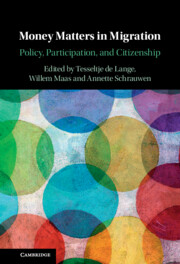Book contents
- Money Matters in Migration
- Money Matters in Migration
- Copyright page
- Contents
- Notes on Contributors
- 1 Money Matters in Migration: A Synthetic Approach
- Part I Migration
- 2 The Changing Landscape of Multilateral Financing and Global Migration Governance
- 3 Digging a Moat around Fortress Europe: EU Funding as an Instrument of Exclusion
- 4 The “Refugee Hospital”. Aid Money, Migration Politics, and Uncertain Care in Neoliberal Morocco
- 5 Cash Rules Everything: Money and Migration in the Colombian-Venezuelan Borderlands
- 6 Recruitment Fees, Indebtedness, and the Impairment of Asian Migrant Workers’ Rights
- 7 Pushing Out the Poor: Unstable Income and Termination of Residence
- 8 Follow the Money: Income Requirements in Norwegian Immigration Regulations
- Part II Participation
- Part III Citizenship
- Index
- References
6 - Recruitment Fees, Indebtedness, and the Impairment of Asian Migrant Workers’ Rights
from Part I - Migration
Published online by Cambridge University Press: 12 November 2021
- Money Matters in Migration
- Money Matters in Migration
- Copyright page
- Contents
- Notes on Contributors
- 1 Money Matters in Migration: A Synthetic Approach
- Part I Migration
- 2 The Changing Landscape of Multilateral Financing and Global Migration Governance
- 3 Digging a Moat around Fortress Europe: EU Funding as an Instrument of Exclusion
- 4 The “Refugee Hospital”. Aid Money, Migration Politics, and Uncertain Care in Neoliberal Morocco
- 5 Cash Rules Everything: Money and Migration in the Colombian-Venezuelan Borderlands
- 6 Recruitment Fees, Indebtedness, and the Impairment of Asian Migrant Workers’ Rights
- 7 Pushing Out the Poor: Unstable Income and Termination of Residence
- 8 Follow the Money: Income Requirements in Norwegian Immigration Regulations
- Part II Participation
- Part III Citizenship
- Index
- References
Summary
This chapter examines the impact of recruitment fees and debt in intra-Asian labour migration. It explores the connection between financial decisions taken during recruitment at origin and the legal protection of migrants at destination. The link between these temporal and spatial dimensions is often overlooked in literature, particularly from a legal perspective. The chapter analyses data on Asian countries to characterize existing recruitment models and the policy responses to address them. The purpose is to design a comprehensive response to the negative externalities of the prevalent recruitment model in Asia. The chapter presents legal perspectives and conceptualizations applied to recruitment fees in literature. It identifies the recruitment fees’ structure and presents the typology of fees charged to migrant workers. It analyses the consequences of migration financing methods in the creation of a cycle of debt. Finally, it reflects on how migration-related debt is shaped and which forces contribute to its lastingness. In its concluding remarks, the chapter advocates a holistic approach, encompassing the legal and economic features of the recruitment process.
- Type
- Chapter
- Information
- Money Matters in MigrationPolicy, Participation, and Citizenship, pp. 93 - 111Publisher: Cambridge University PressPrint publication year: 2021



